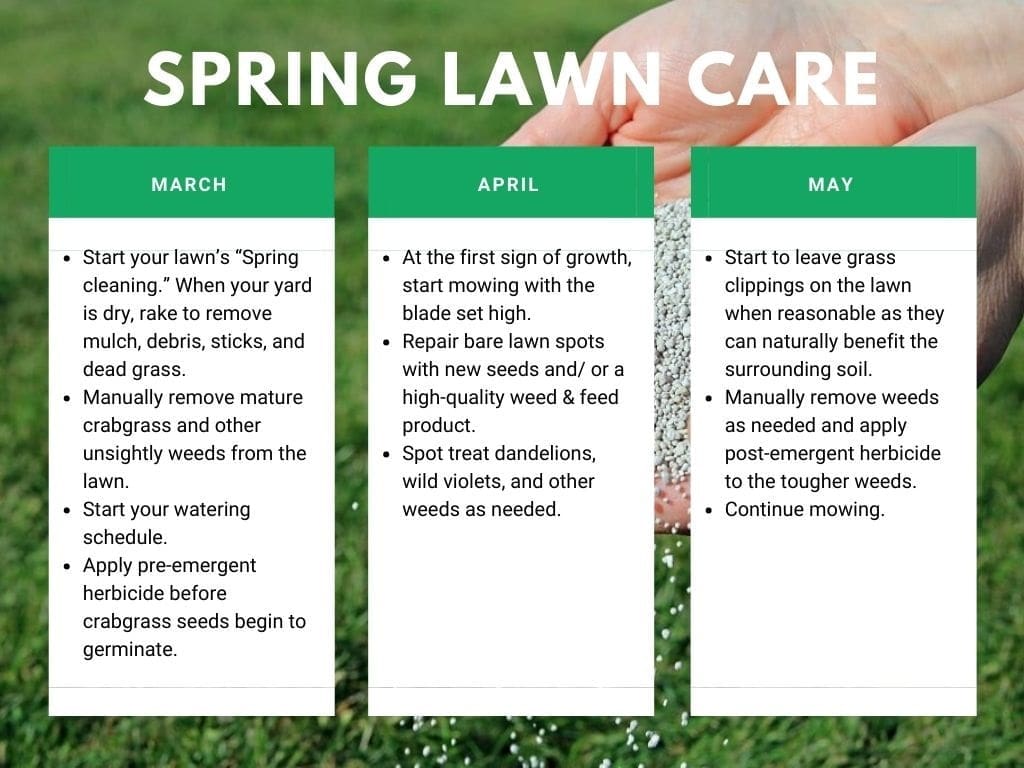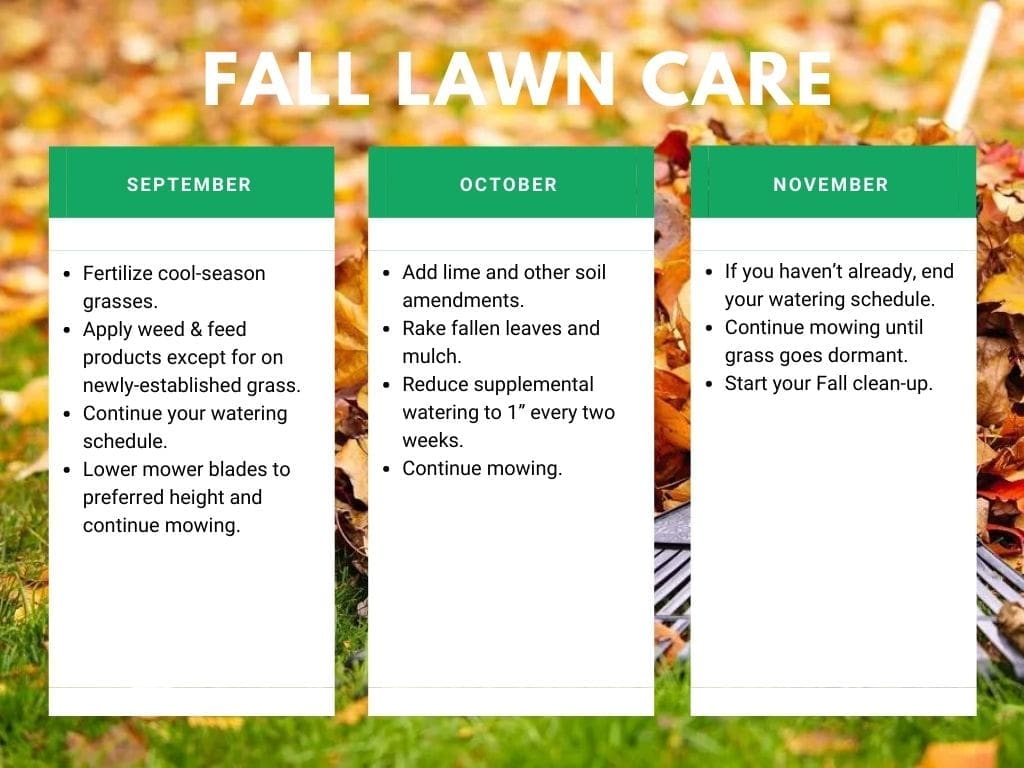Curious about what the best Midwest lawn care schedule looks like? Believe it or not, your Wisconsin lawn care calendar should vary based on the season. Whether you’re in Green Bay, Milwaukee, or Madison, understanding your lawn care needs in the different seasons will help promote a healthy lawn.
Various treatments are more effective and will best promote a flourishing lawn at different times of the year, and with the help of our commercial lawn care company, you can perfectly time and schedule your lawn care treatments.
From when to lay lawn fertilizer to when to dethatch lawn in Wisconsin, we are breaking down everything you need to know about your month-to-month lawn care needs. Let’s dive right in!
Spring Lawn Care in Wisconsin

For the ideal lawn care schedule, Midwest cities can trust our seasonal guides to assist. Starting with the early spring season, our lawn needs are specifically targeting that post-winter lawn, addressing all lawn problems that may have emerged after months of frigid weather. Here’s what we recommend in the early spring season.
1. Clean Up
For your spring lawn, it’s best to begin by cleaning up your landscaping. This spring cleaning can be done with a rake, helping remove any dead grass or other dead debris, including weeds, crabgrass, goosegrass, and barnyard grass. Additionally, take the time to pick up any other sticks and debris that may have built up on your lawn over the course of the winter.
2. Mow High
Now that you’ve done some cleanup, it’s time to grab the lawn mower. In the spring, ensure that your mower blade is set to the highest possible settings for your grass. By cutting grass high, you can promote a thicker lawn with deeper roots, ensuring you better crowd out weeds.
3. Apply Fertilizer
After a long winter, your lawn is in need of extra nutrients to boost its strength and kill any weeds that may sprout up. With the right slow-release fertilizer for your grass type and proper grass seed, you will help your lawn thrive after winter dormancy, boosting growth for a more lush, thick lawn.
4. Beat Weeds
Next on the spring to-do list is weed control. Whether you have dandelions or wild violets, the right weed control will help kill broadleaf weeds, without damaging the rest of your lawn. We recommend you spot-treat dandelions and other weeds, using spray weed control to address these broadleaf weeds. As part of this process, be sure to avoid disturbing the grass roots, as this will unearth dormant weed seeds, further fueling the issue.
5. Patch and Thicken
Say goodbye to bare spots and patches on your lawn. Repair your lawn with both cool and warm-season turf, implementing this new grass in the early spring for cool-season grasses and late spring for warm-season grasses. Additionally, if your lawn is thin, thicken it by overseeding, creating a more lush lawn.
6. Aerate
Aerating your soil is an essential step in your spring lawn care schedule. By aerating the soil, you can help promote better absorption of water and nutrients, boosting your soil pH, as well as helping your lawn flourish.
March
Of all the spring months, March is mostly about preparation, with the real spring lawn care beginning in April and May. But there are some important preparation steps you can take to get a jump start!
- Start your lawn’s “Spring cleaning.” When your yard is dry, rake to remove mulch, debris, sticks, and dead grass.
- Manually remove mature crabgrass and other unsightly weeds from the lawn.
- Start your watering schedule.
- Apply pre-emergent herbicide before crabgrass seeds begin to germinate.
April
It’s officially spring and time to get to work on reviving your lawn!
- If you didn’t begin in March, start on your lawn clean up, using a light rake to remove any dead grass, leaves, and debris from seasons past.
- Prepare your mower in advance, ensuring the blade is sharp, the oil is changed, and the tires are full.
- At the first sign of growth, start mowing with the blade set high.
- Repair bare lawn spots with new seeds and/ or a high-quality weed & feed product.
- Spot treat dandelions, wild violets, and other weeds as needed.
- Address any grubs early. Controlling grubs all comes down to prevention, so get to it right away to prevent them from damaging your lawn.
May
May is another busy month for lawn care as we begin to head into warmer temperatures and the summer season. With this in mind, we recommend:
- Start to leave grass clippings on the lawn when reasonable as they can naturally benefit the surrounding soil.
- Manually remove weeds as needed and apply post-emergent herbicide to the tougher weeds.
- Continue mowing, removing about one-third of the current grass height and maintaining an overall height of 3 to 4 inches.
- Re-seed any bare spots to address lawn growth early.
Summer Lawn Care in Wisconsin

Summer brings warmer temperatures. and hot sun beating down on your lawn, and while this is a great season for grass growth and fun in the sun, it requires some additional maintenance to keep your grass healthy. Let’s break it down.
1. Mow High
A summer lawn is most healthy when it is equipped with long, deep, healthy roots that go deep into the moist soil. The best way to promote these deep roots is to mow high, using sharp mower blades to create a clean cut on your grass without promoting moisture loss.
2. Treat Grubs
The last thing you want is a grub problem this season. Keeping pests from munching on your grassroots, creating dead patches and brown spots is a must for promoting a green lawn, and timing your application this season before the grubs hatch will ensure a healthier lawn. This is best done in late spring or early summer.
3. Water
For green, growing grass, giving your lawn at least 1 inch of water each week will best help it thrive. Whether you opt for irrigation or get lucky with rainfall, take the time to water your lawn. If you irrigate, do so early in the morning to best prevent water loss.
4. Feed
Last on your summer to-do list is feeding your lawn. Summer feeding is great for both warm and cool-season grasses, helping boost growth and keep your grass from dying in the summer heat and drought. Be sure to follow recommended feeding suggestions based on your grass type to prevent insect attacks.
June
June marks the start of the summer season and a great time to see some early success with your lawn. As you pull out your grill and welcome guests for a picnic, here are some essential lawn care tips to follow this month:
- Ensure that your lawn gets at least one inch of water per week.
- Raise your mower blade to 3-4 inches for higher grass blades that shade roots and continue mowing.
- Keep an eye out for insects, pests, and other lawn problems in order to address them early.
July
With July bringing some of the warmest temperatures, plus a lack of rain and high humidity, your lawn is susceptible to disease and general drought. As part of our lawn care schedule, Midwest lawns are best maintained this month by:
- Treat your lawn for newly-hatched pests like grubs that feed on grass roots near the surface.
- Continue your watering schedule.
- Continue mowing.
- Test your soil pH to ensure your lawn has the essential nutrients it needs.
- As part of your lawn fertilizer schedule, Wisconsin residents should apply fertilizer to assist hungry roots.
August
August still counts as summer in our books but does have us preparing for the fall season ahead, too. To wrap up your summer maintenance and begin prepping for cooler months this fall, try:
- Test your soil and make any necessary corrections before seeding.
- Aerate and dethatch your lawn.
- Overseed established lawns and seed new lawns (45 days before expected frost).
- After seeding, keep the grass area consistently watered.
- Continue to watch for insects and treat them as needed.
- Continue your watering schedule.
- Continue mowing.
Fall Lawn Care in Wisconsin

Fall is all about preparing for the harsh winter ahead, requiring major lawn maintenance to keep your grass green and healthy and best armed against the stress winter can cause. As part of your fall lawn care, we recommend:
1. Fertilize
Particularly for cool-season grass, fall allows for optimal growing conditions. To help your grass thrive, follow our Wisconsin lawn fertilizer schedule and fertilize your lawn once around Labor Day, and again around six to eight weeks later.
2. Seed
To address any bare areas in your lawn, use the fall season to law down seed. This is particularly beneficial in the Midwest, where you can use this as a chance to thicken a thin lawn.
3. Mulch Leaves
With leaves falling and covering your lawn, we recommend chopping up leaves with your mower, creating smaller pieces that can lay on your lawn without harming the grass, helping them to decompose in the months to come.
4. Mow Short
While we recommend you mow high in spring and summer, it’s time to mow short this fall. Come late fall, we recommend dropping your mower height to cut your lawn to 1 to 2 inches shorter than you did before. Particularly in areas with falling leaves, this shorter grass will help prevent the leaves from creating a mat over your grass and prevent snow mold in the winter.
5. Aerate
It’s officially the best time of year to aerate your lawn! Before your lawn becomes dormant with the frigid winter temperatures, aerate your soil so it gets the nutrients and hydration it needs this season. Trust us, your roots will be thanking you later!
September
It’s officially autumn! To ring in the season of pumpkin spice and orange hues, we are preparing our lawn for the winter. Here’s where to begin.
- Fertilize cool-season grasses.
- Apply weed & feed products except for on newly-established grass.
- Continue your watering schedule.
- Lower mower blades to the preferred height and continue mowing.
October
With all the ghouls and goblins running around your lawn this October, there are a few lawn care musts to add to your to-do list.
- Add lime and other soil amendments.
- Rake fallen leaves and mulch.
- Reduce supplemental watering to 1” every two weeks.
- Continue mowing.
November
At this point in the season with temperatures dropping and the winter chill setting in, there is much less to do as part of our Wisconsin lawn care calendar. For those finishing up some last-minute lawn care needs, here’s what we recommend.
- If you haven’t already, end your watering schedule.
- Continue mowing until the grass goes dormant.
- Start your fall clean-up.
Winter Lawn Care in Wisconsin

While your lawn care calendar may seem pretty light this winter, some essential lawn maintenance needs should be done to avoid long-term lawn problems. And yes, even though your lawn may be covered in snow, some things can be done. Here’s what we recommended for your Winter lawn care.
1. Limit Lawn Traffic
As temperatures cool, your grass will grow dormant. To protect this resting lawn, try to keep foot traffic to a minimum, ensuring your grass doesn’t get too damaged in the frigid winters.
2. Melt Ice Carefully
We know better than anyone how serious a Midwest winter can be. To help reduce that ice build-up from our cold temperatures and storms, choose ice melt products that are safe to use around your lawn, keeping in mind that formulas like rock salt can be damaging to plant roots.
3. Make Plans
The best lawn care comes with a plan. Keeping any lawn problems you ran into in the last year in mind, come up with a plan in advance of the warmer seasons ahead to be ready to best care for your lawn. Whether it be sharpening your mower blades or beginning to schedule your lawn feedings, setting out a plant will help you better prepare for a healthy lawn in the new year.
December
December is all about the holiday season, and with that comes a much lighter Wisconsin lawn care calendar. While you shop for the family, consider adding just a few minor maintenance steps to your checklist.
- Winterize your lawn mower and other yard maintenance tools.
- Make sure your equipment is properly stored away from the harsh weather.
- Ensure that pathways are cleared to keep people from walking on your lawn when the snow comes.
January
Similar to January, there isn’t a whole lot of lawn maintenance to worry about! However, it is time to begin thinking about the next season, so take a look at your tools and ensure everything is in tip-top shape for when it comes time to get to work.
- Prep your lawn care tools. Sharpen blades and replace any broken parts for tools you might need when spring arrives.
- Abide by the local snow removal laws and keep excess snow from sidewalks, other walking paths, and driveways.
February
Spring is coming! While your winter lawn care routine is still quite light, take a look at the health of your lawn to begin assessing what will be needed in the months to come.
- On a dry day, test your soil pH. This should be done at least every three to four years. Treat any issues that you find such as lawn moss.
- Flush all areas of your lawn that have been in contact with salt or pets with water to minimize harmful compounds from roots before the grass starts to grow again in the Spring.
Wisconsin Lawn Care FAQs
When is the best time to fertilize a lawn in Wisconsin?
Great question! The best time to fertilize your lawn in Wisconsin is in the spring to help wake up your grass, as well as in summer to help with growth during the hotter season. This will help ensure a healthy, lush lawn.
When is the best time to dethatch lawn in Wisconsin?
The best time to dethatch your lawn in Wisconsin is when it’s actively growing. For cool-season grasses, this happens around early spring and early fall. For warm-season grasses, it’s best to dethatch in late spring and early summer.
When is the best time to aerate lawn in Wisconsin?
The best time to aerate your lawn in Wisconsin is during that active growth period when your grass is growing the most. Typically, this is best done in May and again between September and October.
Midwest Lawn Care: The Bottom Line
No matter how big or small your lawn is, implementing a proper lawn care calendar will help ensure your grass gets the love it needs throughout the seasons. From grass seed and lawn food to preventing insect pests and other lawn problems, having a lawn calendar planned in advance will help you better care for your lawn, no matter the time of year.
If you need assistance with your lawn care or would like some expert advice from a commercial landscaping company, our team at Earth Development is happy to help. With a range of landscaping and lawn care services and over 20 years of work in the Midwest, we know just how to help.
